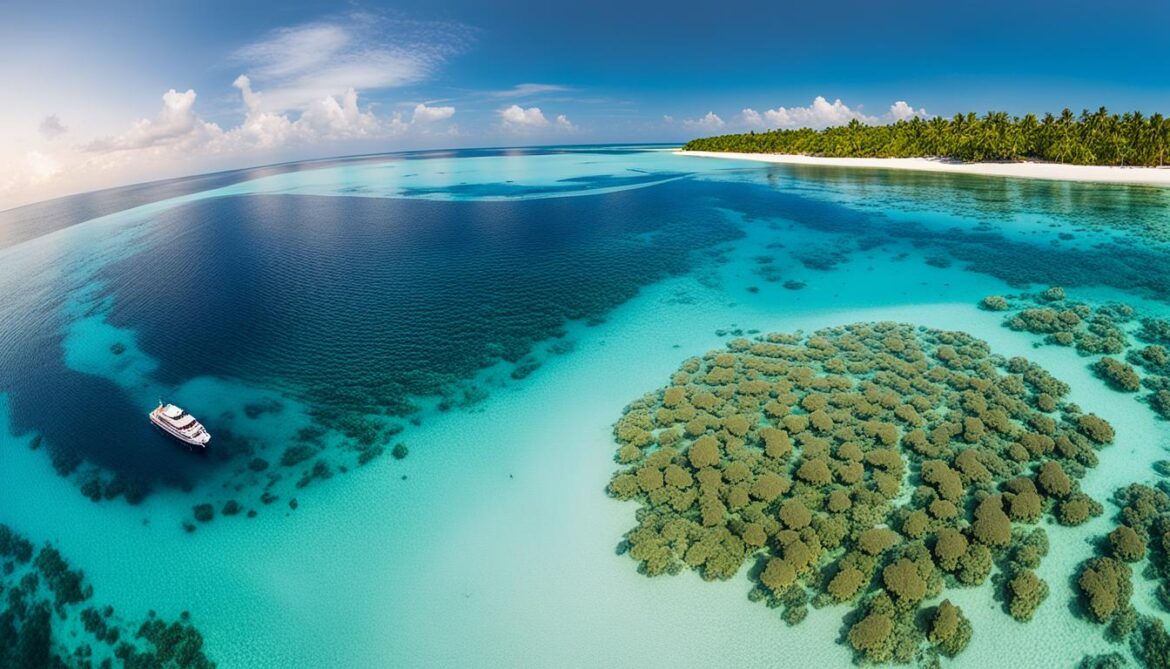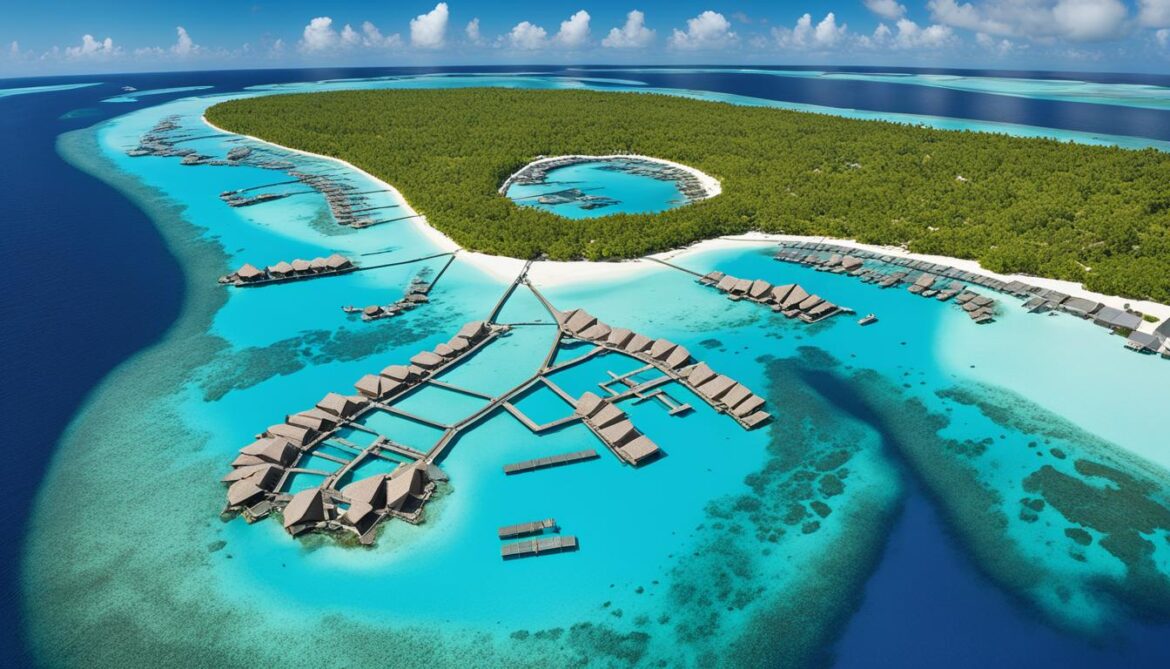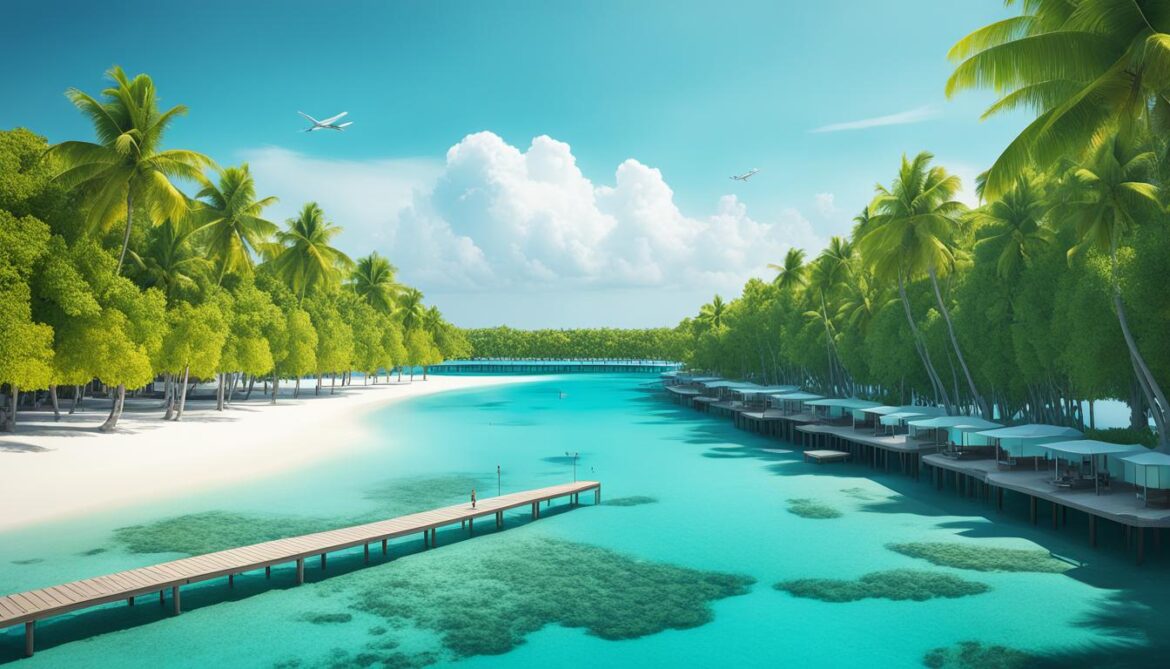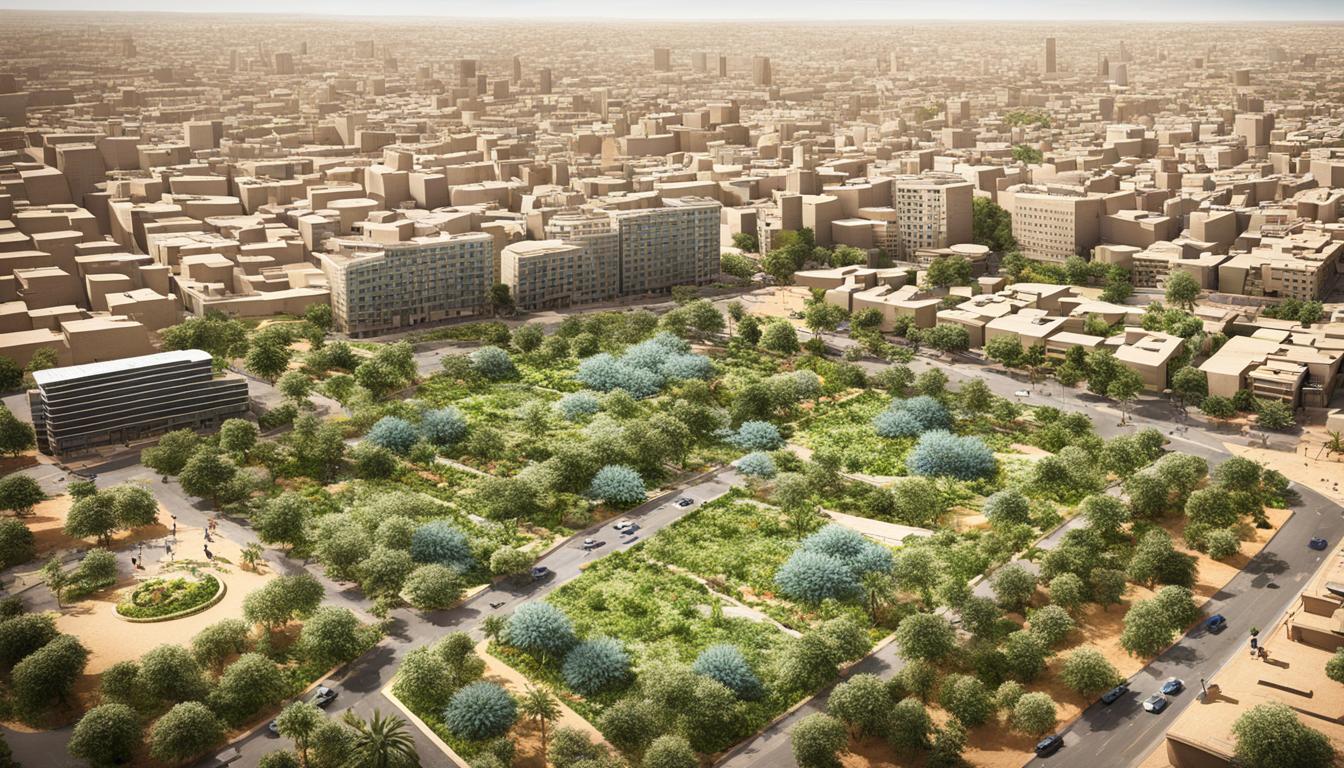Maldives Biodiversity and the Built Environment
Did you know that the coral reef systems of the Maldives cover an area of approximately 8,900 km2, making it the seventh largest in the world? The Maldives is not only home to stunning marine ecosystems but also boasts a remarkable diversity of wildlife, including 1,100 species of fish, 21 species of whales and dolphins, and 180 species of corals. With such incredible biodiversity, it’s crucial to ensure the sustainable development and conservation of the Maldives’ natural environment.
Key Takeaways:
- The Maldives is home to the seventh largest coral reef systems in the world, covering an area of 8,900 km2.
- The country has a diverse range of marine and terrestrial wildlife, with thousands of species of fish, corals, whales, dolphins, and more.
- Sustainable development and conservation are essential to protect the biodiversity of the Maldives and its built environment.
The Threats to Maldives Biodiversity
The pristine marine ecosystems of the Maldives face a multitude of threats that put the country’s biodiversity at risk. These threats come from both natural factors and human activities, highlighting the urgency of conservation efforts.
Natural Threats
Climate change poses a significant threat to the marine ecosystems of the Maldives. Rising sea temperatures have led to coral bleaching, causing the loss of vibrant coral reefs that are home to numerous marine species. Coral bleaching disrupts the delicate balance of these ecosystems and reduces biodiversity.
Human Activities
Human activities, such as tourism and over-exploitation, also contribute to the degradation of Maldives’ biodiversity. The rapid growth of the tourism industry has led to increased pollution from waste disposal and untreated sewage. These pollutants contaminate the marine environment, threatening the survival of many marine species.
Over-exploitation of resources, such as unsustainable fishing practices, further exacerbates the loss of biodiversity in the Maldives. The demand for seafood, both locally and internationally, puts pressure on fish populations and disrupts the natural balance of marine ecosystems.
Additionally, infrastructure development, including land reclamation and construction projects, poses a significant threat to the fragile ecosystems of the Maldives. These activities result in habitat destruction and fragmentation, further reducing biodiversity.
It is crucial to address these threats through sustainable practices and conservation efforts. Protecting the biodiversity of the Maldives is not only essential for the environment but also for the long-term well-being of the country and its people.
The National Biodiversity Strategy and Action Plan (NBSAP)
The Maldives has implemented the National Biodiversity Strategy and Action Plan (NBSAP) to guide biodiversity conservation efforts. The NBSAP emphasizes the importance of ecological sustainability, individual responsibility, equitable sharing of benefits, accountability, transparency, and stakeholder participation in achieving sustainable development.
The Ministry of Environment and Energy leads the implementation of the NBSAP, collaborating with other key institutions to incorporate relevant activities into their work programs. This multi-stakeholder approach ensures that biodiversity conservation is integrated across various sectors and promotes a holistic approach to sustainability.
To ensure the NBSAP remains updated and aligned with global biodiversity targets, the Maldives has prioritized its review. A technical committee has been established to guide the review process and ensure that the NBSAP effectively addresses the challenges and opportunities in biodiversity conservation.
Through the NBSAP, the Maldives encourages active stakeholder participation, recognizing the importance of engaging communities, civil society organizations, and other relevant stakeholders in decision-making processes. The involvement of diverse stakeholders ensures that the NBSAP reflects the needs, concerns, and aspirations of all those who depend on and interact with the rich biodiversity of the Maldives.
“Our National Biodiversity Strategy and Action Plan is a collective effort to conserve the unique biodiversity of the Maldives while promoting sustainable development. We believe that by actively involving stakeholders, we can create a future where biodiversity thrives, benefiting both present and future generations.” – Ministry of Environment and Energy
Key Elements of the National Biodiversity Strategy and Action Plan:
- Ecological sustainability
- Individual responsibility
- Equitable sharing of benefits
- Accountability and transparency
- Stakeholder participation
The Review Process of the NBSAP:
| Step | Description |
|---|---|
| 1 | Establishment of a technical committee |
| 2 | Review of the current NBSAP |
| 3 | Identification of gaps and areas for improvement |
| 4 | Incorporation of Aichi Biodiversity Targets |
| 5 | Revision and updating of the NBSAP |
Through the NBSAP, the Maldives aims to ensure the effective and sustainable management of its biodiversity, promoting conservation and sustainable use of natural resources for the benefit of both present and future generations.

Actions Taken to Achieve the Aichi Biodiversity Targets
In their efforts to achieve the 2020 Aichi Biodiversity Targets, the Maldives has implemented various measures to preserve its unique natural heritage. The country has established a total of 44 protected areas, encompassing both marine and terrestrial environments. These protected areas serve as crucial habitats for a diverse range of species and ecosystems across the Maldives.
- Marine Environment: 34 protected areas
- Terrestrial Environment: 10 protected areas
The marine protected areas cover a significant expanse of 428,569 hectares, providing essential habitats for numerous marine species. These areas include fish breeding grounds, bird sanctuaries, micro atolls, islands, mangroves, and other vital marine ecosystems. On the other hand, the terrestrial protected areas, spanning 273 hectares, contribute to the conservation of unique flora and fauna found on land.
In addition to the establishment of protected areas, the Maldives has also implemented specific measures to safeguard the region’s precious wildlife. The country has enacted a ten-year moratorium on turtle harvesting, protecting these magnificent creatures for future generations. Furthermore, the collection of sea turtle eggs has been prohibited in certain regions, ensuring the conservation of these endangered species. Additionally, shark fishing has been banned, offering further protection to these crucial marine predators.
The Maldives has taken significant strides towards the conservation of its marine ecosystems by designating the Hanifaru area as a marine protected area. This area is renowned for its abundant marine life and serves as a vital habitat for various species. Moreover, the establishment of the Baa Atoll as a UNESCO Biosphere Reserve showcases the country’s commitment to long-term biodiversity conservation and sustainable development.

Significance of Protected Areas
Protected areas play a vital role in preserving the unique biodiversity and ecosystems of the Maldives. They serve as safe havens for endangered species, protect critical habitats, and contribute to the overall ecological balance. By establishing marine reserves and terrestrial protected areas, the Maldives ensures the sustainable conservation of its natural heritage, promoting environmental sustainability and preserving the rich biodiversity for future generations.
“Our protected areas are essential in preserving the diverse ecosystems and species that make the Maldives truly remarkable. By embracing the UNESCO Biosphere Reserve concept and implementing a range of conservation measures, we are committed to safeguarding our natural heritage for the benefit of both present and future generations.” – Environmental Minister of the Maldives
Support Mechanisms for National Implementation
In order to facilitate the effective implementation of biodiversity conservation efforts in the Maldives, several support mechanisms have been put in place. These mechanisms aim to address crucial aspects such as legislation, funding, capacity-building, coordination, mainstreaming, and public awareness.
Legislation
While specific legislation is still being formulated, the Maldives has policies and action plans in place for the management and integration of protected areas. These measures contribute to the overall conservation of biodiversity and ensure that the natural resources of the country are protected.
Funding
Efforts are being made to establish financing mechanisms and increase resources for long-term conservation. However, funding for environmental protection in the Maldives is relatively low. It is important to secure adequate financial support to implement conservation strategies effectively and sustainably.
Capacity-building
Capacity-building initiatives play a crucial role in enhancing the skills, knowledge, and technical expertise of individuals involved in biodiversity conservation. By investing in capacity-building programs, the Maldives can strengthen its human resources and ensure that effective conservation practices are implemented.
Coordination
Coordination among different stakeholders is vital for the successful implementation of biodiversity conservation efforts. The Maldives emphasizes the need for collaboration and coordination among government agencies, non-governmental organizations, and local communities to ensure a unified approach towards conservation.
Mainstreaming
Mainstreaming biodiversity considerations into various sectors and policies is essential for the long-term sustainability of conservation efforts. By integrating biodiversity into sectors such as tourism, fisheries, and urban planning, the Maldives can ensure that conservation is a part of the overall development agenda.
Public Awareness
Public awareness plays a crucial role in fostering a sense of responsibility and engagement towards biodiversity conservation. In the Maldives, public awareness of biodiversity issues is being raised through education programs, media campaigns, and leveraging social media platforms. By promoting public awareness, the Maldives can mobilize support for biodiversity conservation on a wider scale.

Table: Funding Allocation for Biodiversity Conservation in the Maldives (in Maldivian Rufiya)
| Funding Source | Allocation (in millions) |
|---|---|
| Government | 35 |
| International Aid | 20 |
| Private Sector | 10 |
| Non-Governmental Organizations | 5 |
| Total | 70 |
Mechanisms for Monitoring and Reviewing Implementation
The Maldives is actively working towards establishing robust monitoring and review mechanisms to ensure the effective implementation of biodiversity conservation strategies. These mechanisms play a crucial role in tracking progress, establishing clear indicators, and promoting community participation for better outcomes. Regular evaluation and adjustments to conservation strategies are essential for the long-term sustainability of biodiversity.
Monitoring:
- Tracking progress: The monitoring mechanisms will closely monitor the progress of biodiversity conservation efforts in the Maldives. It will involve collecting data on various indicators, such as the health of coral reef systems, the population of endangered species, and the sustainability of ecosystem services.
- Establishing clear indicators: Clear indicators will be developed to measure the success of conservation strategies. These indicators will provide valuable insights into the effectiveness of initiatives and help identify areas that require further attention.
Review Mechanisms:
- Evaluating outcomes: Review mechanisms will evaluate the outcomes of biodiversity conservation strategies. They will assess the impact of implemented actions, identify strengths and weaknesses, and recommend adjustments as necessary.
- Community participation: Engaging the community in the review process is vital for inclusive decision-making and effective outcomes. Community participation fosters a sense of ownership and responsibility, ensuring that conservation efforts align with local needs and values.
By implementing comprehensive monitoring and review mechanisms, the Maldives can gather valuable data, evaluate the effectiveness of conservation strategies, and make informed decisions for future actions. This collaborative approach involving stakeholders and community participation will contribute significantly to the success of biodiversity conservation initiatives.
“Monitoring and review mechanisms enable us to track our progress, measure the impact of our actions, and engage the community in biodiversity conservation. By involving stakeholders and utilizing clear indicators, we can make informed decisions for the sustainability of our natural resources.”
— Minister of Environment and Energy, Maldives

| Benefits of Monitoring and Review Mechanisms | |
|---|---|
| 1. Enhanced data collection for evaluating conservation efforts | ✔️ |
| 2. Identification of areas requiring additional attention | ✔️ |
| 3. Inclusive decision-making through community participation | ✔️ |
| 4. Evaluation of the impact and effectiveness of conservation strategies | ✔️ |
| 5. Recommendations for adjustments and improvements | ✔️ |
The Economic Case for Biodiversity Conservation
Biodiversity in the Maldives plays a vital role in the country’s economy, particularly in the tourism and fisheries sectors. The unique natural beauty and diverse ecosystems of the Maldives attract visitors from around the world, contributing significantly to the revenue generated by the tourism industry.
Additionally, the fisheries sector heavily relies on the rich biodiversity of the Maldivian waters. The abundance of fish species supports the livelihoods of many Maldivians and contributes to the nation’s food security.
Moreover, Maldivians themselves recognize the value of biodiversity and are willing to invest in its conservation. The local population understands the importance of preserving their natural resources for future generations, and there is a growing sense of responsibility towards sustainable practices.
Preserving biodiversity is not only crucial for ecological conservation but also for the long-term economic sustainability of the Maldives. By protecting and managing the diverse marine and terrestrial ecosystems, the country can ensure the continued growth of its tourism and fisheries sectors while maintaining the overall economic stability.

“Preserving biodiversity is not only crucial for ecological conservation but also for the long-term economic sustainability of the Maldives.”
The economic case for biodiversity conservation must be taken into account when making policies and decisions related to sustainable development in the Maldives. Investing in conservation efforts and sustainable management practices will not only benefit the environment but also contribute to the overall economic prosperity of the nation.
Economic Incentives for Biodiversity Conservation
Existing economic and environmental policies in the Maldives play a crucial role in shaping biodiversity conservation efforts. By implementing economic instruments, such as taxes, fees, and subsidies, the government can create incentives to encourage individuals, businesses, and organizations to actively participate in biodiversity conservation.
Economic instruments can be designed to reward sustainable practices and penalize harmful activities that negatively impact biodiversity. For example, businesses that adopt eco-friendly practices and demonstrate a commitment to biodiversity conservation could benefit from tax incentives or subsidies. On the other hand, those that contribute to biodiversity loss may face additional fees or fines.
Implementing effective economic incentives requires the development of robust policies that align with biodiversity conservation goals. These policies should consider potential impacts on different sectors, while also promoting the principles of sustainable development. By integrating economic instruments into broader policy frameworks, the Maldivian government can ensure a balanced and holistic approach towards biodiversity conservation.
“Economic instruments provide valuable tools for incentivizing biodiversity conservation and sustainable practices.” – Ministry of Environment and Energy, Maldives
To improve the effectiveness of biodiversity conservation efforts, it is essential to allocate sufficient funding and ensure financial sustainability. Adequate biodiversity funding allows for the implementation of key initiatives, such as the establishment and management of protected areas, conservation research, and community engagement programs.
Improving biodiversity funding involves exploring diverse funding sources, including both domestic and international channels. The government can allocate a portion of its budget specifically for biodiversity conservation, while also seeking partnerships with international organizations and donor countries. Furthermore, collaboration with private sector entities, non-profit organizations, and philanthropic foundations can help diversify funding streams and strengthen conservation efforts.

Effective financial management is essential for ensuring the long-term sustainability of biodiversity funding. Transparent mechanisms, rigorous monitoring, and evaluation systems are necessary to track the allocation and utilization of funds. By demonstrating accountability and showing measurable conservation outcomes, the Maldives can attract ongoing support and sustained funding for biodiversity conservation initiatives.
“Investing in biodiversity not only protects the unique natural heritage of the Maldives but also contributes to long-term economic resilience and sustainable development.” – Ministry of Finance, Maldives
Conclusion
The biodiversity of the Maldives is a priceless treasure that is under threat from various factors. However, the country has taken significant steps to preserve and protect its unique natural heritage. Through the implementation of the National Biodiversity Strategy and Action Plan and efforts to achieve the Aichi Biodiversity Targets, the Maldives has demonstrated its commitment to sustainable development and ecological conservation.
To ensure the success and long-term sustainability of biodiversity conservation, support mechanisms and monitoring mechanisms are being established. These mechanisms will allow for the effective management and evaluation of conservation initiatives, while also promoting stakeholder participation and community involvement.
Furthermore, the economic case for biodiversity conservation highlights the importance of integrating biodiversity considerations into policies and leveraging economic instruments. Recognizing the economic values associated with biodiversity, the Maldives can harness the potential of its rich natural resources to drive sustainable development and create a harmonious balance between economic growth and environmental sustainability.
By prioritizing sustainable development and conservation, the Maldives can safeguard its remarkable biodiversity and built environment for the benefit of present and future generations. Through continued dedication and collective efforts, the Maldives can serve as a global model for achieving a harmonious coexistence between human activities and the natural world.








